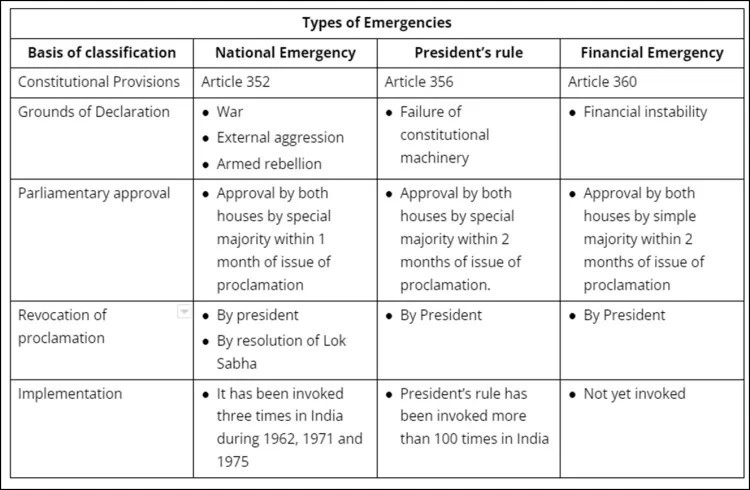Why in News?
The Union Cabinet passed a resolution marking 50 years of the Emergency imposed in 1975. It honours those who fought for democratic rights, declares 2025 as ‘Samvidhan Hatya Divas’, and reaffirms commitment to constitutional values and democratic principles.
Description:
- Definition:
The Union Cabinet is the highest decision-making body in India’s executive structure, headed by the Prime Minister. - Constitutional Status:
- The term Cabinet was added by the 44th Constitutional Amendment Act (1978) in Article 352.
- Defined as: “Council consisting of the Prime Minister and Ministers of Cabinet rank appointed under Article 75.”
- Nature:
- Drawn from the Council of Ministers; only includes senior-most ministers.
- Based on British parliamentary conventions.
- Functions:
- Policy formulation and decision-making at the national level.
- Crisis management, legislative planning, and budgetary control.
- Advises the President, and its advice is binding.
- Handles foreign policy, high-level appointments, and inter-ministerial coordination.
- Principles Governing the Cabinet:
- Collective Responsibility (Article 75):
- The Cabinet is collectively responsible to the Lok Sabha.
- If a no-confidence motion passes, the entire Cabinet must resign.
- Individual Responsibility:
- Ministers hold office at the pleasure of the President (on PM’s advice).
- Collective Responsibility (Article 75):
- Prime Minister’s Role:
- Head of the Cabinet.
- Chairs meetings and allocates portfolios.
- Acts as the link between the President and Cabinet.
- Can reshuffle/dismiss ministers.
- Political Homogeneity:
- Ideally, all cabinet ministers are from the same political party for coherence.
- Coalition governments reduce this homogeneity.
- Kitchen Cabinet:
- An informal group of trusted aides (often includes non-officials).
- Holds significant influence but has no constitutional status.
Cabinet Committees:
- Nature:
- Extra-constitutional; not mentioned in the Constitution.
- Set up under the Rules of Business.
- Types:
- Standing Committees: Permanent in nature.
- Ad Hoc Committees: Temporary, task-specific.
- Purpose:
- Reduces workload of Cabinet.
- Enables detailed examination of issues.
- Facilitates inter-ministerial coordination.
- Composition:
- Consists mainly of Cabinet Ministers.
- Non-Cabinet Ministers may also be included.
- PM usually chairs the committees; exceptions exist.
- Current Cabinet Committees (2025):
- Appointments Committee of the Cabinet
- Cabinet Committee on Political Affairs
- Cabinet Committee on Economic Affairs
- Cabinet Committee on Security
- Cabinet Committee on Investment & Growth
- Cabinet Committee on Parliamentary Affairs
- Cabinet Committee on Accommodation
- Cabinet Committee on Employment & Skill Development
- (Note: PM chairs all except last two: Accommodation (chaired by Home Minister) and Parliamentary Affairs (chaired by Defence Minister))

La Excellence IAS Academy, the best IAS coaching in Hyderabad, known for delivering quality content and conceptual clarity for UPSC 2025 preparation.
FOLLOW US ON:
◉ YouTube : https://www.youtube.com/@CivilsPrepTeam
◉ Facebook: https://www.facebook.com/LaExcellenceIAS
◉ Instagram: https://www.instagram.com/laexcellenceiasacademy/
GET IN TOUCH:
Contact us at info@laex.in, https://laex.in/contact-us/
or Call us @ +91 9052 29 2929, +91 9052 99 2929, +91 9154 24 2140
OUR BRANCHES:
Head Office: H No: 1-10-225A, Beside AEVA Fertility Center, Ashok Nagar Extension, VV Giri Nagar, Ashok Nagar, Hyderabad, 500020
Madhapur: Flat no: 301, survey no 58-60, Guttala begumpet Madhapur metro pillar: 1524, Rangareddy Hyderabad, Telangana 500081
Bangalore: Plot No: 99, 2nd floor, 80 Feet Road, Beside Poorvika Mobiles, Chandra Layout, Attiguppe, Near Vijaya Nagara, Bengaluru, 560040

